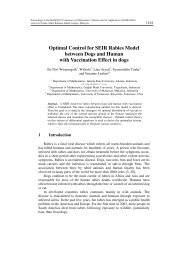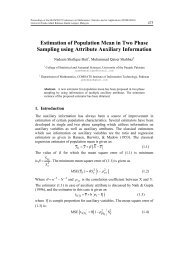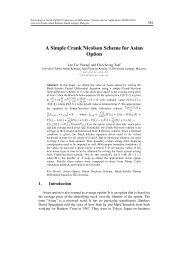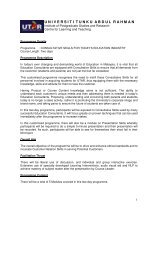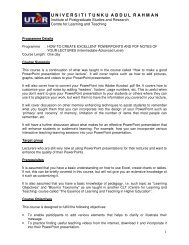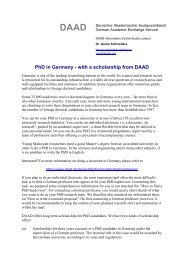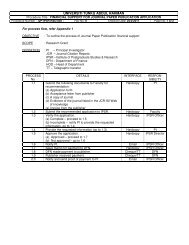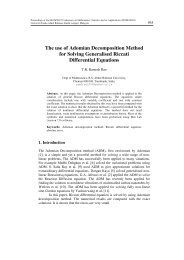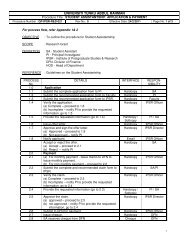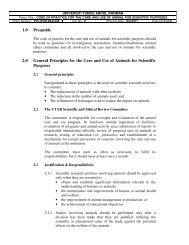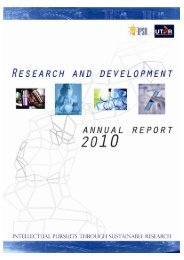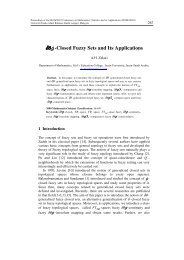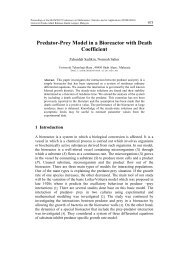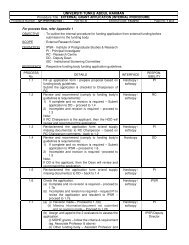Solving Nonlinear Algebraic Equation By Homotopy Analysis Method
Solving Nonlinear Algebraic Equation By Homotopy Analysis Method
Solving Nonlinear Algebraic Equation By Homotopy Analysis Method
You also want an ePaper? Increase the reach of your titles
YUMPU automatically turns print PDFs into web optimized ePapers that Google loves.
Proceedings of the 6th IMT-GT Conference on Mathematics, Statistics and its Applications (ICMSA2010)<br />
Universiti Tunku Abdul Rahman, Kuala Lumpur, Malaysia 712<br />
<strong>Solving</strong> <strong>Nonlinear</strong> <strong>Algebraic</strong> <strong>Equation</strong><br />
<strong>By</strong> <strong>Homotopy</strong> <strong>Analysis</strong> <strong>Method</strong><br />
Chin Fung Yuen (1) , Lem Kong Hoong (2) , Chong Fook Seng (3)<br />
Department of Physical and Mathematical Sciences, Faculty Science,<br />
University Tunku Abdul Rahman (UTAR), Perak Campus,<br />
Jalan Universiti, Bandar Barat<br />
31900 Kampar, Perak, Malaysia.<br />
chinfy@utar.edu.my (1) , lemkh@utar.edu.my (2) , chongfs@utar.edu.my (3)<br />
Abstract. This paper presents an efficient method – <strong>Homotopy</strong> <strong>Analysis</strong> <strong>Method</strong><br />
(HAM) that based on Newton Raphson's method to solve the nonlinear algebraic<br />
equation. This method is more powerful than the Newton Raphson's method in<br />
the sense that this method allows more freedom in choosing the initial<br />
approximation x0<br />
instead of a good x0<br />
that is closed to the root must be<br />
chosen. <strong>By</strong> applying the HAM, it can speed up the iteration and we can control<br />
the convergence rate by the h- curve. Some examples are given to show the<br />
efficiency of the algorithm compare to the Newton- Raphson's method.<br />
1. Introduction<br />
<strong>Solving</strong> nonlinear algebraic equation is a subject of considerable interest and<br />
many developments of the numerical technique have been done, for example<br />
solving the nonlinear algebraic equation by homotopy perturbation method<br />
[1], modified homotopy perturbation method [2], Newton-homotopy<br />
continuation method [3], modified Adomian decomposition method [4],<br />
Newton-homotopy analysis method [5]. Newton Raphson's method is a wellknown<br />
and popular method for solving nonlinear algebraic equation. It has<br />
high efficiency in the convergence speed by choosing a good initial<br />
approximation x 0<br />
. However bad structure of equation or bad initial<br />
approximation x0<br />
will impel some uncontrollable situation, such as overflow,<br />
divergence and etc. In the recent paper [5], an efficient method – <strong>Homotopy</strong><br />
<strong>Analysis</strong> <strong>Method</strong> (HAM) that based on Newton Raphson's method is proposed<br />
for solving nonlinear algebraic equation. This proposed method is applied to<br />
solve test problems in order to assess its validity and accuracy.
Proceedings of the 6th IMT-GT Conference on Mathematics, Statistics and its Applications (ICMSA2010)<br />
Universiti Tunku Abdul Rahman, Kuala Lumpur, Malaysia 713<br />
2. <strong>Homotopy</strong> <strong>Analysis</strong> <strong>Method</strong> (HAM)<br />
Consider the nonlinear algebraic equation<br />
( x) = x ∈ R<br />
f 0 ,<br />
(1)<br />
We assume that α is a zero of the function f ( x)<br />
in (1).<br />
<strong>By</strong> using Taylor’s expansion near x<br />
2<br />
3<br />
δ δ<br />
4<br />
( x δ ) = f ( x) + δf<br />
′( x) + f ′′( x) + f ′′′ ( x) O( δ )<br />
f + + .<br />
2 6<br />
Neglecting terms of higher order, we have<br />
2<br />
3<br />
δ δ<br />
f ( x + δ ) = 0 ≈ f ( x) + δf<br />
′( x) + f ′′( x) + f ′′′<br />
( x)<br />
.<br />
2 6<br />
<strong>Solving</strong> for δ<br />
yields<br />
( x)<br />
′( x)<br />
( x)<br />
( x)<br />
( x)<br />
( x)<br />
2<br />
3<br />
f δ f ′′ δ f ′′′<br />
δ = − − − .<br />
f 2 f ′ 6 f ′<br />
We define a function<br />
( x)<br />
( x)<br />
( x)<br />
( x)<br />
2<br />
3<br />
δ f ′′ δ f ′′′<br />
g ( δ ) = −δ<br />
− − = c ,<br />
2 f ′ 6 f ′<br />
where<br />
f ( x)<br />
c = .<br />
f ′ x<br />
( )<br />
Now homotopy analysis method (HAM) is proposed to solve equation (1) by<br />
using Newton- Raphson method. Let q ∈ [ 0,1]<br />
denotes the so called<br />
embedding parameter, h ≠ 0 an auxiliary parameter, H ( δ ) ≠ 0 an auxiliary<br />
function, and L an auxiliary linear operator. We construct the zero- order
Proceedings of the 6th IMT-GT Conference on Mathematics, Statistics and its Applications (ICMSA2010)<br />
Universiti Tunku Abdul Rahman, Kuala Lumpur, Malaysia 714<br />
deformation equation [6]<br />
( 1 q) L[ v( q)<br />
− δ<br />
0<br />
] = qhH<br />
( δ ){<br />
g v( q)<br />
− [ ]} , (2)<br />
δ is the initial approximation of δ , and ( )<br />
where 0<br />
v q is an unknown<br />
function. It should be emphasized that we have great freedom to choose the<br />
auxiliary parameter h , the auxiliary function H ( δ ), the initial approximation<br />
δ<br />
0 , and the auxiliary linear operator L .<br />
When q = 0 , equation (2) becomes<br />
[ v( 0)<br />
− δ<br />
0<br />
] = 0<br />
L ,<br />
when q = 1, equation (2) becomes<br />
[ v( q)<br />
] = 0<br />
g ,<br />
since ≠ 0<br />
h and ( δ ) ≠ 0<br />
H .<br />
So, we see that, when q increases from 0 to 1, v( q)<br />
δ to the solution δ . Expanding v( q)<br />
guess 0<br />
q , we have<br />
varies from the initial<br />
in Taylor series with respect to<br />
v<br />
( ) ∑ ∞ q =<br />
0<br />
+<br />
m=<br />
where<br />
m<br />
δ δ mq , (3)<br />
1<br />
( q)<br />
m<br />
1 d v<br />
δ<br />
m<br />
=<br />
m q= 0 .<br />
m!<br />
dq<br />
If the auxiliary linear operator, the initial guess, the auxiliary parameter and the<br />
auxiliary function are so properly chosen, the series (3) converges at q = 1<br />
such that<br />
+ ∑ ∞ m<br />
δ = δ<br />
0<br />
δ m<br />
q<br />
(4)<br />
m=<br />
1
Proceedings of the 6th IMT-GT Conference on Mathematics, Statistics and its Applications (ICMSA2010)<br />
Universiti Tunku Abdul Rahman, Kuala Lumpur, Malaysia 715<br />
which must be one of solutions of the original nonlinear equation, as proved by<br />
Liao [7]. Choosing h = −1<br />
and H ( δ ) = 1, equation (2) becomes<br />
( 1−<br />
q) L[ v( q)<br />
− δ<br />
0<br />
] + q{<br />
A[ v( q)<br />
] − c}<br />
= 0<br />
which is used mostly in the homotopy perturbation method (HPM), whereby<br />
the solution is obtained directly, without using Taylor series. The comparison<br />
between HAM and HPM can be found in [8].<br />
Setting H ( δ ) = 1 and differentiating equation (2) m times with respect to the<br />
embedding parameter q and then setting q = 0 and finally dividing them by<br />
m!, we have the so- called mth- order deformation equation<br />
L<br />
r<br />
[ δ − χ δ ] R ( δ )<br />
m<br />
where<br />
( )<br />
m<br />
h , (5)<br />
m− 1<br />
=<br />
m m−1<br />
⎧0,<br />
m ≤ 1<br />
χ<br />
m<br />
= ⎨ ,<br />
⎩1,<br />
m > 1<br />
1 d<br />
1 !<br />
( m − )<br />
[ A[ v( q)<br />
] − c]<br />
m−1<br />
R r m<br />
δ<br />
m−1<br />
=<br />
m−1<br />
q=<br />
0 , (6)<br />
and<br />
r<br />
δ =<br />
n<br />
δ<br />
dq<br />
( t) , δ ( t) , δ ( t) ,..., δ ( )}<br />
{<br />
0 1 2 m<br />
t<br />
.<br />
The δ from HAM is then incorporated into the follow Newton Raphson’s<br />
method like iteration formula,<br />
x<br />
δ<br />
( x )<br />
n+1 = xn<br />
+<br />
n<br />
.<br />
The numerical iteration formula of Newton Raphson’s method for solving<br />
equation is<br />
x<br />
= x<br />
−<br />
f<br />
( xn<br />
)<br />
′( x )<br />
n+1 n<br />
. (7)<br />
f<br />
n
Proceedings of the 6th IMT-GT Conference on Mathematics, Statistics and its Applications (ICMSA2010)<br />
Universiti Tunku Abdul Rahman, Kuala Lumpur, Malaysia 716<br />
If a good approximation x0<br />
is chosen, iteration (7) may converge to the root<br />
of the equation (up to precision required) in just a few iterations. When a bad<br />
approximation x0<br />
is chosen, the iteration (7) may converge slowly such that<br />
many iterations are needed for precision required or it may even lead to<br />
divergent results. <strong>By</strong> means of HAM, the initial approximation x0<br />
may be<br />
chosen freely instead of a good x0<br />
closed to the exact root. Moreover, the<br />
iteration converges faster and we can control the convergence rate by altering<br />
the auxiliary parameter h . The value of h can be determined by potting the<br />
so- called h - curve, as suggested by Liao.<br />
3. Test problem<br />
We present some examples to illustrate the efficiency of the algorithm compare<br />
to the Newton- Raphson's method.<br />
Example 1: f ( x) = x − cos x = 0<br />
The table below lists the results obtained by HAM and the Newton Raphson’s<br />
method. The initial value and the number of iteration to obtain the root up to 6<br />
decimal places are shown in the table. As we see from the table below, it is<br />
clear that the result obtained by the HAM is more efficient in solving the<br />
equation. This example shows that even a bad initial value is chosen, which is<br />
far from the root, the HAM still convergences in a few iterations. Moreover,<br />
even though the Newton- Raphson’s method is convergent for certain initial<br />
value, HAM converges faster to the root.<br />
<strong>Method</strong><br />
Initial value,<br />
x 0<br />
Number<br />
iterations, n<br />
f<br />
( ) x n<br />
HAM<br />
1 2 −7<br />
− 2.229505×<br />
10<br />
( m = 3,<br />
h = −0.5)<br />
50 6 −7<br />
− 2.229505×<br />
10<br />
Newton- Raphson's 1 3 −7<br />
− 2.229505×<br />
10<br />
50 Divergent -<br />
Here are some iterations show by HAM and Newton Raphson’ method for<br />
initial value x = 0<br />
50 ,
Proceedings of the 6th IMT-GT Conference on Mathematics, Statistics and its Applications (ICMSA2010)<br />
Universiti Tunku Abdul Rahman, Kuala Lumpur, Malaysia 717<br />
HAM<br />
x<br />
x<br />
x<br />
x<br />
x<br />
x<br />
x<br />
x<br />
0<br />
1<br />
2<br />
3<br />
4<br />
5<br />
6<br />
7<br />
= 50.000000<br />
= 1.176610×<br />
10<br />
= −2.156798×<br />
10<br />
= 0.000000<br />
= 0.734375<br />
= 0.739086<br />
= 0.739085<br />
= 0.739085<br />
9<br />
58<br />
Newton- Raphson method<br />
x<br />
x<br />
x<br />
x<br />
x<br />
x<br />
0<br />
1<br />
2<br />
3<br />
4<br />
5<br />
7<br />
= 50.000000<br />
= −16.476901<br />
= −7.182040<br />
= 28.719786<br />
= −23.328018<br />
= −11.620473<br />
x6<br />
= −4.880916<br />
x = −2.338584<br />
3<br />
Example 2: f ( x) = x = 0<br />
A real root is x = 0. In the table below, we list the results obtained by HAM and<br />
the Newton Raphson’s method. The initial value and the number of iteration to<br />
obtain the root up to 6 decimal places are shown in the table. It is clear that the<br />
result obtained by the HAM is more efficient while the result by Newton-<br />
Raphson's method is divergent. Newton Raphson’s method diverges even an<br />
initial value that is closed to the root is chosen. On the other hand, HAM<br />
converges for both the initial values.<br />
Here are some iterations obtained by HAM and Newton Raphson’ method for<br />
initial value x 1 and x 50 ,<br />
0 =<br />
0 =<br />
( ) x n<br />
<strong>Method</strong> Initial value Number<br />
iterations<br />
f<br />
HAM<br />
1 115 0.000000<br />
( m = 3,<br />
h = −0.1)<br />
50 146 0.000000<br />
Newton- Raphson's 1 Divergent -<br />
50 Divergent -
Proceedings of the 6th IMT-GT Conference on Mathematics, Statistics and its Applications (ICMSA2010)<br />
Universiti Tunku Abdul Rahman, Kuala Lumpur, Malaysia 718<br />
HAM<br />
x<br />
x<br />
x<br />
.<br />
.<br />
.<br />
x<br />
x<br />
x<br />
0<br />
1<br />
2<br />
114<br />
115<br />
116<br />
= 1.000000<br />
= −0.880000<br />
= 0.774400<br />
= −0.000001<br />
= 0.000000<br />
= −0.000000<br />
Newton- Raphson method<br />
x<br />
x<br />
x<br />
x<br />
x<br />
x<br />
x<br />
0<br />
1<br />
2<br />
3<br />
4<br />
5<br />
7<br />
8<br />
= 1.000000<br />
= −2.000000<br />
= 4.000000<br />
= −8.000000<br />
= 16.000000<br />
= −32.000000<br />
x6<br />
= 64.000000<br />
x = −128.000000<br />
= 256.000000<br />
HAM<br />
x<br />
x<br />
x<br />
.<br />
.<br />
.<br />
x<br />
x<br />
x<br />
0<br />
1<br />
2<br />
145<br />
146<br />
147<br />
= 50.000000<br />
= −44.000000<br />
= 38.720000<br />
= −0.000001<br />
= 0.000000<br />
= −0.000000<br />
Newton- Raphson method<br />
x<br />
x<br />
x<br />
x<br />
x<br />
x<br />
x<br />
x<br />
0<br />
1<br />
2<br />
3<br />
4<br />
5<br />
6<br />
8<br />
= 50.000000<br />
= −100.000000<br />
= 200.000000<br />
= −400.000000<br />
= 800.000000<br />
= −1600.000000<br />
= 3200.000000<br />
= 12800.000000<br />
Example 3: f ( x) = x<br />
3 + 4x<br />
2 + 8x<br />
+ 8 = 0<br />
A real root is x = −2<br />
. The initial value and the number of iteration to obtain the<br />
root up to 6 decimal places are shown in the table. It is clear that the result<br />
obtained by the HAM is more efficient in the sense that it requires less<br />
iterations then the Newton- Raphson’s method to obtain the root.
Proceedings of the 6th IMT-GT Conference on Mathematics, Statistics and its Applications (ICMSA2010)<br />
Universiti Tunku Abdul Rahman, Kuala Lumpur, Malaysia 719<br />
<strong>Method</strong> Initial value Number iterations f ( )<br />
HAM<br />
1 3 0.000000<br />
( m = 3,<br />
h = −0.9)<br />
50 7 0.000000<br />
Newton- Raphson's 1 6 0.000000<br />
50 13 0.000000<br />
x n<br />
A few iterations by both methods are listed below for initial value x = 0<br />
1<br />
and x = 0<br />
50 ,<br />
HAM<br />
Newton- Raphson method<br />
x<br />
x<br />
x<br />
x<br />
x<br />
x<br />
0<br />
1<br />
2<br />
3<br />
4<br />
5<br />
= 1.000000<br />
= −0.839882<br />
= −2.001045<br />
= −2.000000<br />
= −2.000000<br />
= −2.000000<br />
x<br />
x<br />
x<br />
x<br />
x<br />
x<br />
0<br />
1<br />
2<br />
3<br />
4<br />
5<br />
7<br />
= 1.000000<br />
= −0.105263<br />
= −1.106642<br />
= −2.060344<br />
= −2.001816<br />
= −2.000001<br />
x6<br />
= −2.000000<br />
x = −2.000000<br />
HAM<br />
x<br />
x<br />
x<br />
x<br />
x<br />
x<br />
x<br />
0<br />
1<br />
2<br />
3<br />
4<br />
5<br />
7<br />
8<br />
= 50.000000<br />
= 23.680395<br />
= 10.820140<br />
= 4.494731<br />
= 1.282956<br />
= −0.625917<br />
x6<br />
= −2.020002<br />
x = −2.000000<br />
= −2.000000<br />
Newton- Raphson method<br />
x<br />
x<br />
x<br />
.<br />
.<br />
.<br />
x<br />
x<br />
x<br />
0<br />
1<br />
2<br />
12<br />
13<br />
14<br />
= 50.000000<br />
= 32.877086<br />
= 21.455714<br />
= −2.000080<br />
= −2.000000<br />
= −2.000000
Proceedings of the 6th IMT-GT Conference on Mathematics, Statistics and its Applications (ICMSA2010)<br />
Universiti Tunku Abdul Rahman, Kuala Lumpur, Malaysia 720<br />
4. Conclusion<br />
The Newton- Raphson’s method is a popular numerical method. However, it<br />
still has some well- known critical defects such as requirement of a good initial<br />
value and the problem of divergence. HAM in general converges faster and<br />
allows more freedom in choosing of the initial value. This paper provides an<br />
alternative way for solving nonlinear equation. Our results show that HAM is<br />
able to manage problems that Newton Raphson’s method fails.<br />
References<br />
1. J.H. He, Application of homotopy perturbation method to nonlinear wave equations, Chaos, Solitons,<br />
& Fractals 26 (3) (2005), pp. 695-700.<br />
2. A. Golbabai and M. Javidi, A third- order Newton type method for nonlinear equations based on<br />
modified homotopy perturbation method, Applied Mathematics and Computation 191 (2007), pp.<br />
199-205.<br />
3. Tzong- Mou Wu, A study of convergence on the Newton- homotopy continuation method, Applied<br />
Mathematics and Computation 168 (2005), pp. 1169-1174.<br />
4. E. Babolian and J. Biazar, Solution of nonlinear equations by modified Adomian decomposition<br />
method, Applied Mathematics and Computation 132 (2002), pp. 167-172.<br />
5. S. Abbasbandy, Y. Tan and S. J. Liao, Newton-homotopy analysis method for nonlinear equations,<br />
Applied Mathematics and Computation 188 (2007), pp. 1794-1800.<br />
6. S. J. Liao, An approximate solution technique which does not depend upon small parameters (Part 2):<br />
an application in fluid mechanics, Int. J. <strong>Nonlinear</strong> Mech. 32 (5) (1997) pp. 815-822.<br />
7. S. J. Liao, Beyond Perturbation: introduction to the <strong>Homotopy</strong> <strong>Analysis</strong> <strong>Method</strong>, Chapman & Hall/<br />
CRC Press, Boca Raton, 2003.<br />
8. S. J. Liao, Comparison between the homotopy analysis method and homotopy perturbation method,<br />
Applied Mathematics and Computation 169 (2005), pp. 1186-1194.



